 [I]t seems like every summer I become fixed on a particular fruit. In the past, it’s been strawberries, blueberries or cherries. I’ve been fanatic for apricots and peaches. This year, it’s been “plummy,†as the deeply jeweled and juicy fruit began appearing in my mind before it ever arrived on the market scene. I grew up with a plum tree, and I have to say, when it bloomed in the late spring, I don’t know whose nose was in its heavenly aromatic pale blossoms more, me or the rightfully fervent bees. It’s no wonder that a bloom with that kind of spicy fragrance becomes such a lovely floral fruit.
[I]t seems like every summer I become fixed on a particular fruit. In the past, it’s been strawberries, blueberries or cherries. I’ve been fanatic for apricots and peaches. This year, it’s been “plummy,†as the deeply jeweled and juicy fruit began appearing in my mind before it ever arrived on the market scene. I grew up with a plum tree, and I have to say, when it bloomed in the late spring, I don’t know whose nose was in its heavenly aromatic pale blossoms more, me or the rightfully fervent bees. It’s no wonder that a bloom with that kind of spicy fragrance becomes such a lovely floral fruit.
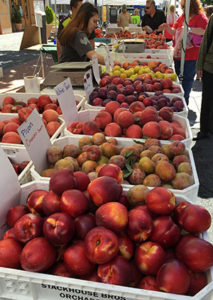 I think the true seasonality of plums is what got me longing for them and what makes them special. In a world where nearly every fruit is available all year long, plums still represent summertime — it’s when you find these unique beauties and it’s when they are their best. At their ripest, they are bursting with juice, like a water balloon meant to quench any desire for deep sweetness.
I think the true seasonality of plums is what got me longing for them and what makes them special. In a world where nearly every fruit is available all year long, plums still represent summertime — it’s when you find these unique beauties and it’s when they are their best. At their ripest, they are bursting with juice, like a water balloon meant to quench any desire for deep sweetness.
Once these stone fruits arrived this season, it was as if I willed a plum extravaganza. At the farmer’s market, I saw plums ranging in a rainbow of color, from soft greenish- to lemon-yellow to deep bluish-black.I saw crosses of everything from plums plus peaches plus apricots to a plum-cherry cross that truly captured the best sweet essences of both fruits.
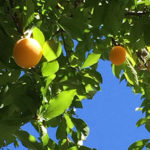 Throughout this farmer’s market season, I gathered plums, drawn to their colors and sampling each jewel for their varying levels of tartness, sweetness and juiciness. Then, as plum happenstance would have it, a co-worker introduced me to a cluster of old golden plum trees on a slanted hillside where we work. By the time I was aware of them, much of their bounty had dropped and rolled down into a ravine of rotting sweetness to be enjoyed by birds, bugs and rodents alone. Still, plenty remained on the trees for me (and I vowed to mark my calendar for plumbing these plums next early June), and I only slid and scratched my way to minor injuries and slight stickiness in the gathering process.
Throughout this farmer’s market season, I gathered plums, drawn to their colors and sampling each jewel for their varying levels of tartness, sweetness and juiciness. Then, as plum happenstance would have it, a co-worker introduced me to a cluster of old golden plum trees on a slanted hillside where we work. By the time I was aware of them, much of their bounty had dropped and rolled down into a ravine of rotting sweetness to be enjoyed by birds, bugs and rodents alone. Still, plenty remained on the trees for me (and I vowed to mark my calendar for plumbing these plums next early June), and I only slid and scratched my way to minor injuries and slight stickiness in the gathering process.
As I greedily accumulated plums, and I sought to save what I could for the future in jars of thickly dense jam, from both the slightly tart golden plums from work (they almost have a tinge of citrus) to the the purple and ruby plums and plum-mixes that honor a range of stone fruits.
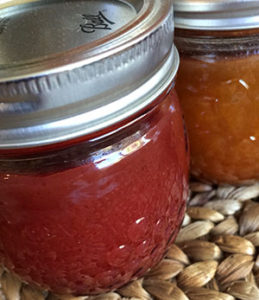
Plum Jam
Makes 8 1/2-pint jars
6 cups plums, pitted and chopped (mix a variety for a range of flavors)
3/4 cup water
4 cups sugar
1 teaspoon cinnamon
1 tablespoon lemon juice
2 to 3 tablespoons low-sugar pectin
Combine plums, water, lemon juice, cinnamon and pectin in a large heavy pot.
Bring to a rolling boil over medium-high heat, stirring constantly.
Add sugar; return to a rolling boil. Boil hard 1 minute, stirring constantly.
Pour hot into hot, sterilized jars, leaving 1/4″ head space. Lid the jars tightly
Process 15 minutes in boiling water bath.
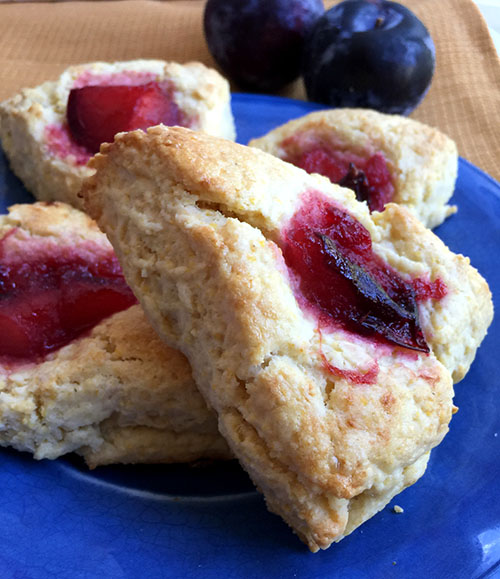
[C]learly, I was not the only plum-obsessed, for I found not one, but two New York Times recipes featuring plums that both called to me. In case anyone wondered, I am a scone fan, and a cornmeal scone recipe filled with a honey-and-plum stovetop jam, was quite a sumptuous treat. I altered the recipe slightly, replacing the bay leaf with lemon thyme and reducing the cornmeal just a tad (and increased the flour), since cornmeal can sometimes give a a little more crunch than some like.
Cornmeal Plum Scones
By Melissa Clark, New York Times
Makes 8 scones
3 tablespoons/45 millititers honey
1 bay leaf
¾ pound plums/1/3 kilogram, halved, pitted and then cut into 1-inch cubes
¾ cup/175 milliliters heavy cream, more as needed
1 large egg, at room temperature
1 â…” cups/275 grams all-purpose flour
â…“ cup/60 grams fine cornmeal
3 tablespoons/35 grams sugar
2 teaspoons/7 grams baking powder
½ teaspoon/2 grams kosher salt
6 tablespoons/85 grams unsalted butter at room temperature, cubed, plus more for serving if you like

Put honey and bay leaf in a medium skillet over medium heat. Simmer until honey is bubbling and turns a shade darker, about 2 minutes.
Place plums in honey. Cook, without moving, until undersides are golden brown, about 5 minutes. Stir plums and cook 1 to 2 minutes longer, until tender but not falling completely apart. If the caramel starts to get too brown, stir in a teaspoon or two of water and lower the heat. Scrape plums and syrup into a bowl and chill for at least 1 hour. (Plum compote can be made up to a week ahead.)
Heat oven to 400 degrees. Line a baking sheet with parchment.
In a small bowl or measuring cup, mix together the cream and egg.
In a large bowl, whisk together flour, cornmeal, sugar, baking powder and salt (or you can do this in a food processor). Using a fork, pastry cutter or your fingertips, cut butter into flour until the mixture forms coarse crumbs (or pulse in a food processor). Drizzle in as much of the cream mixture as you need to make a smooth, moist but not wet dough. Save remaining cream-egg mixture for brushing.
Turn dough out onto prepared baking sheet. Pat into a 1 1/4-inch thick round. Using a paring knife, cut 8 wedge-shaped scones (as though you were cutting slices of pie) and push them apart on the baking sheet to separate them 1/2 inch apart. Brush dough with remaining cream-egg mixture, or use more cream if you’ve run out of the mixture.
Using your fingertips, make a deep indentation about 1 inch in diameter in the center of each scone. Tuck some plum into the hole. Transfer pan to oven and bake until uniformly golden brown, 15 to 17 minutes.
Cool 5 minutes on the pan, then transfer to a wire rack to cool completely. Serve scones with extra plum compote and butter on the side if you like.
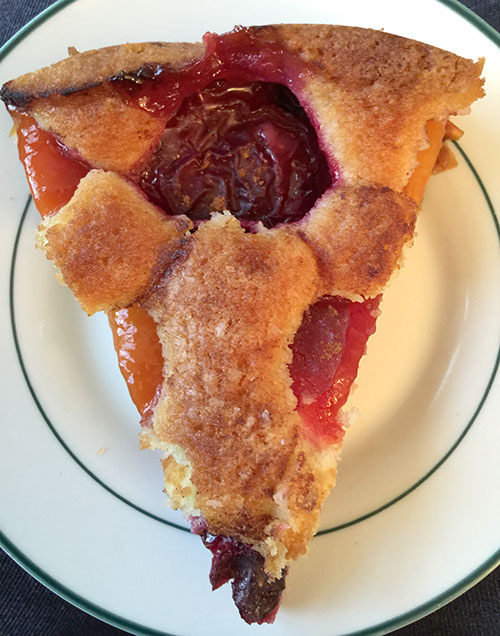
[B]y the time the Plum Torte recipe crossed my path, fate allowed me just enough dark Santa Rosa and diminutive cherry/plum cross. This recipe, by Marian Burros, was published every year in the New York Times as a reader-requested tradition. After making it, I could see why. Just enough light, tender cake exists to hold sweet pockets of juicy bursting plums. They bejewel this beautiful cake in an earthy elegant way that makes a bouquet of flowers unnecessary.
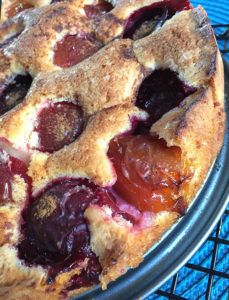
Original Plum Torte
By Marian Burros, New York Times
Makes 8 servings
¾ cup sugar
½ cup unsalted butter
1 cup unbleached flour, sifted
1 teaspoon baking powder
Pinch of salt (optional)
2 eggs
24 halves pitted purple plums
Sugar, lemon juice and cinnamon for topping
Heat oven to 350 degrees.
Cream the sugar and butter in a bowl. Add the flour, baking powder, salt and eggs and beat well.
Spoon the batter into a spring form of 8, 9 or 10 inches. Place the plum halves skin side up on top of the batter. Sprinkle lightly with sugar and lemon juice, depending on the sweetness of the fruit. Sprinkle with (about) 1 teaspoon of cinnamon, depending on how much you like cinnamon.
Bake one hour, approximately. Remove and cool; refrigerate or freeze if desired. Or cool to lukewarm and serve plain or with whipped cream.
To serve a torte that was frozen, defrost and reheat it briefly at 300 degrees.